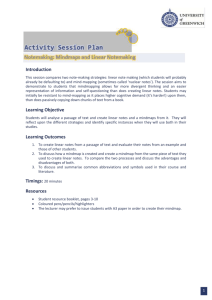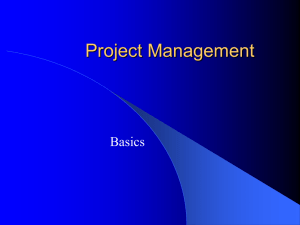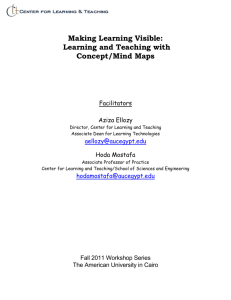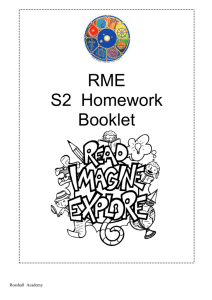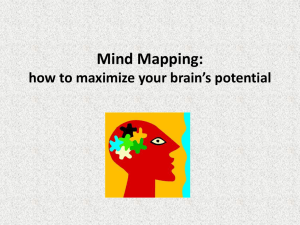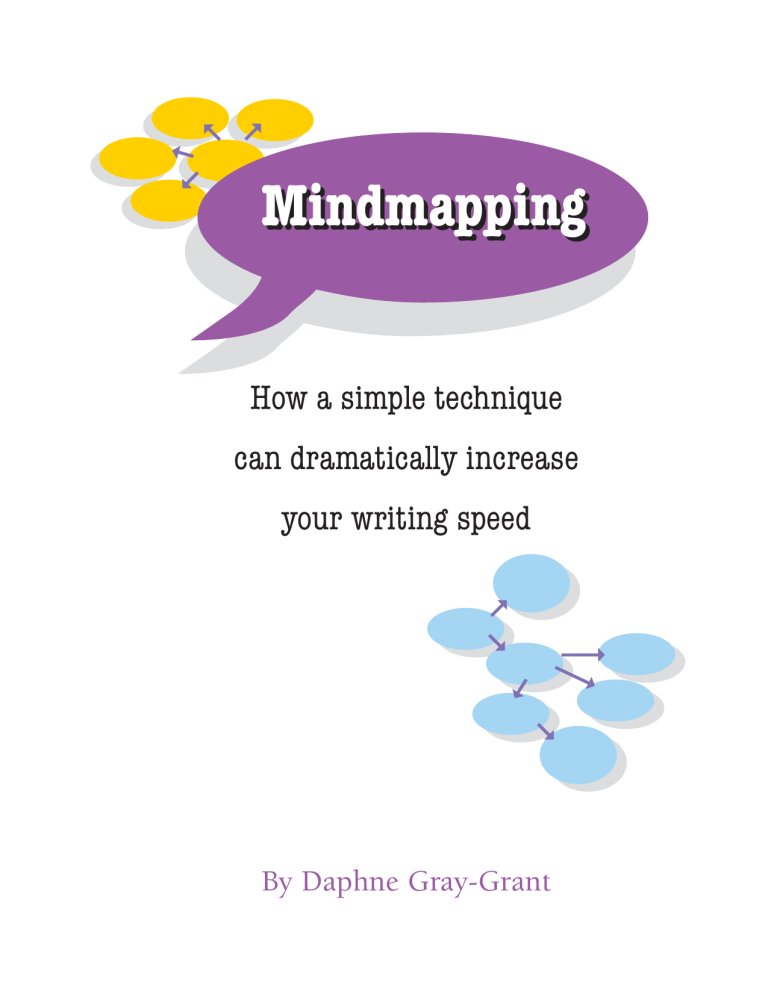
Mindmapping
How a simple technique
can dramatically increase
your writing speed
By Daphne Gray-Grant
Contents
Introduction . . . . . . . . . . . . . . . . . . . . . . . . . . . . . . . . . . . . . . .3
What is a mindmap? . . . . . . . . . . . . . . . . . . . . . . . . . . . . . . . . .4
How can you create your own mindmap? . . . . . . . . . . . . . . . .5
Why do mindmaps work? . . . . . . . . . . . . . . . . . . . . . . . . . . . .8
What people say about mindmapping . . . . . . . . . . . . . . . . . .10
Advanced mindmapping techniques . . . . . . . . . . . . . . . . . . .12
Resources . . . . . . . . . . . . . . . . . . . . . . . . . . . . . . . . . . . . . . . .13
Books
Software
Conclusion . . . . . . . . . . . . . . . . . . . . . . . . . . . . . . . . . . . . . . .15
About Daphne . . . . . . . . . . . . . . . . . . . . . . . . . . . . . . . . . . . . .16
Next steps . . . . . . . . . . . . . . . . . . . . . . . . . . . . . . . . . . . . . . . .17
If you haven’t received this e-book directly from The Publication Coach,
it’s an illegal copy.
http://www.publicationcoach.com © 2006 Daphne Gray-Grant, All Rights Reserved
Introduction
When you sit down to write an article, story or other piece of work, one of two problems often
occurs:
(1) You have dozens of ideas competing for your attention and you don’t know where to begin.
Thoughts flicker through your mind and disappear. Zip – they’re gone! You’re like a child at
the circus – so many lovely, colourful things are competing for your attention, you don’t know
where to focus. As a result, you feel lost and overwhelmed.
OR (more commonly)
(2) You are totally bereft of ideas. You have nothing to say. You despair of ever getting anything
written. As you sit down to write, you feel like a labourer trudging through a muddy field—
it’s as if your boots are being sucked off your feet with each tiresome step you try to take.
These situations are polar opposites – but, interestingly, they lead to the same result. You can’t write.
This report you’re reading describes a technique for getting around both of these problems. It’s
called mindmapping, although it’s sometimes also known as clustering or webbing.
It will help you write faster, have more fun doing it and produce better results. It doesn’t cost a
thing. And it’s easy to learn. So let’s get started.
http://www.publicationcoach.com © 2006 Daphne Gray-Grant, All Rights Reserved
3
What is a mindmap?
If you haven’t seen a mindmap before, you’re probably curious about what one looks like. So, before
talking about the theory, let me show you an actual map. In fact, this is the first one I created for
writing this report.
Adam
Gabor
Alice
Comments
from users
Different
from
outlining
Erin
Mindmapping
Why it
works
How to do it
Turn paper
sideways
Right brain
Who?
Tony Buzan
“Aha!”
Metaphor
Creativity
Brainstorming
with oneself
Write FAST
Gabriele Rico
You don’t
have to
finish
Don’t exclude
Use colour
Have fun!
As you can see, it’s simply a group of words with circles drawn around them and lines connecting
them to other words.
Now you’re probably wondering how a few words and squiggles on a page could possibly help with
writing. So here’s the secret: mindmaps are personal. This map is meaningful to me because each
word harbours an association for me. And even if you created a mindmap on exactly the same topic
and used exactly the same words (which is pretty unlikely), you would still have different
associations for them.
Like snowflakes and human beings, each mindmap is unique.
http://www.publicationcoach.com © 2006 Daphne Gray-Grant, All Rights Reserved
4
How can you create your own mindmap?
One of the best things about mindmapping is that it’s so simple.
Take a blank piece of 8.5 x 11-inch paper and turn it sideways. (This may sound picky, but it’s
crucial. Turning the paper so it sits landscape fashion will give you more “room” to write all around
your central idea. This will help make your mind feel open and expansive.) If you’re creating a
mindmap for a long piece of writing – such as a book – you might even want to get a large piece of
blank newsprint or butcher’s paper and stretch it across your office or dining room table, so you can
really spread out!
Write your subject or central idea in the middle of the paper. For example, if you’re writing an
article on the advertising campaign for a new cellphone, you might write: “cellphone ad campaign.”
Draw a circle around this phrase or idea.
Now, just let your mind wander. Each time a word or association pops into your head, write it down
and draw a circle around it. Link it to the word/phrase that inspired the thought by drawing a line
to it, as you can see in the example here:
Fred in
Marketing
Ad agency
Who
Cellphone
ad campaign
Length of
each
campaign?
Creative
concept
What
Radio
Use exotic
animals
TV
Bright
colours
Whimsical
Newspapers
& magazines
Billboard &
bus shelters
http://www.publicationcoach.com © 2006 Daphne Gray-Grant, All Rights Reserved
5
If you have lots of ideas, this process will be very fast. If you have only a few ideas, you’ll likely start
slowly (okay, maybe very slowly), but you will pick up speed as you go. But whatever you’re feeling,
be sure to keep these simple rules in mind:
Don’t judge or evaluate. Every idea is acceptable. Just write them all down on the page.
Reassure yourself that if you don’t like some of the ideas, you can always cross them out
later. But “judging” while you’re mindmapping will cause you to choke. Instead, you should
simply write down your thoughts as fast as you possibly can. If you find your mind going
blank, don’t panic! Just keep your pen moving by drawing empty lines, colouring in the
circles or doodling.
Don’t limit yourself to just the facts. The words and phrases you write down should
also include feelings, images and metaphors. These will help make your writing more
interesting, colourful and lively – and will help inspire you to want to write.
Don’t structure. Apart from drawing links between related ideas, don’t classify or organize.
That’s separate work and it should come later.
Don’t over-think. People sometimes wonder if each thought must be distilled to a single
word. No! Some people like to use single words; others use phrases or sentence fragments.
While a mindmap is meant to be succinct, it doesn’t need to be curt. Do what suits you best.
Be creative. Use different coloured pens or pencils. Include drawings or doodles. Your
brain likes to be amused; keep it happy while you’re working.
It may have occurred to you that mindmapping is similar to brainstorming. Indeed it is, and you
might even want to think of it as brainstorming with yourself.
In fact, for many articles, I find it’s useful to create two mindmaps – one before I do any research or
interviews (so I know what to research) and a second one when I want to take the information I’ve
collected and actually write.
How do you know when your mindmap is done? Keep putting words on the page until you’ve filled
it OR until you feel like writing your article, story or report. What usually happens is that you will
get to a certain point in your map and you’ll think, “Now I know what I want to say.”
http://www.publicationcoach.com © 2006 Daphne Gray-Grant, All Rights Reserved
6
Some people call this the “click,” the “shift” or the “aha!” moment. Mindmaps can be used for
many purposes (more on that later), but the “aha!” experience is what renders them so valuable for
writers. I find it’s the “aha” that makes me want to write. When the “aha” strikes, I feel like a horse
at the starting gate, straining at the reins, waiting for the starter’s pistol. Let me get going!
Compare this to writing from an outline. Outlines usually carry a sense of duty and obligation. I
find it’s far too easy to become obsessed with putting X number of words in each category, instead of
feeling energized or inspired. The outline may organize, but it also enervates, leaving me with the
depressing thought that I have an awful lot of work to do.
I must confess, I’ve become so addicted to the “aha” experience that I now use mindmaps even for
very short articles (fewer than 300 words). I frequently don’t even finish the map – instead, I just
stop when I hit the “aha.”
As a result, I now have a box full of half-completed mindmaps. But that’s okay. They’ve done their
job.
http://www.publicationcoach.com © 2006 Daphne Gray-Grant, All Rights Reserved
7
Why do mindmaps work?
How can something that’s as simple as a mindmap possibly make such a big difference to anyone’s
writing? Funnily enough, that question was easier to answer 30 years ago – when we believed we
understood the brain better than we actually do.
You may recall the research from those early days of brain research. Remember the talk about the
“left” hemisphere and the “right” hemisphere? As a result of some interesting studies on people who
were epileptic, scientists thought they had discovered that the two sides of our brains operate
completely differently. At the time, they said that the brain worked this way:
Left hemisphere
Right hemisphere
Logical
Emotional
Sequential
Simultaneous
Responds to detail
Responds to the whole
Good with syntax and grammar
Good with images
“Sees” in words
“Sees” in pictures
Common sense also seems to support these conclusions. Think about the long list of your friends
and acquaintances. You’ve probably noticed that the “artistic” or “creative” ones are more often lefthanded, a trait that occurs in only 10 percent of the population. My brother-in-law, who is an
architect, tells me that when he was at architecture school, fully 80 percent of his class was lefthanded! (This appears to make sense when you realize that each side of the brain controls the
opposite side of the body. Thus, all those left-handed architects could be thought to have greater
access to the right or so-called picture side of their brains – a useful trait for someone who designs
buildings.)
Sounds good in theory, doesn’t it? But some relatively new technology has allowed scientists to
measure exactly where brain activity occurs, and they now tell us that the brain is a whole lot
“messier” than the theory supposed. Left versus right sounds great, but the reality is, our brains are
more like popcorn machines. Those kernels (synapses) are flying in every direction!
http://www.publicationcoach.com © 2006 Daphne Gray-Grant, All Rights Reserved
8
So why did I tell you this long convoluted story if it isn’t true? The answer is simple: as you sit
down to write, it’s useful to imagine that your brain is neatly divided in two. In other words, it’s a
good metaphor. Writers often tend to see writing as “one task.” In fact, it’s a number of distinct jobs
– including researching, creating and editing. Just as it is impossible to be enthusiastic and
depressed at the same time, so too it is impossible to create freely and edit wisely at the same time.
Over the next 20 years, scientists will undoubtedly have a lot more to tell us about exactly which
parts of the brain are responsible for what. For now, it’s probably enough to know that when you
edit or polish your writing, you’re using one part of your brain, and when you sit down to create,
you’re using a different part. And mindmapping can help you find and use that creative part.
http://www.publicationcoach.com © 2006 Daphne Gray-Grant, All Rights Reserved
9
What people say about mindmapping
Sometimes corporate writing doesn’t feel very creative. So you might be tempted to think that
mindmapping is meant for fiction writers, who not only have the luxury of “making things up” but
who also have licence to include all sorts of colourful images.
While of course mindmapping is a great tool for such writers, it’s equally valuable for non-fiction,
business-oriented writing. Here is what some dedicated business mindmappers have to say.
Alice, who is a human resources consultant based in Endicott, New York, uses mindmaps for
writing, note-taking and leading seminars. “A mindmap seems clearer to me than an outline could
ever be,” she explains. “One of the biggest benefits is that mindmaps let you figure out your
hierarchy afterwards. Sometimes when we figure out our hierarchy first [as in outlining], we can go
down the wrong path for a very long time and not understand why it doesn’t work.”
Alice also appreciates the concision of a mindmap, because it allows a large number of oftencomplex ideas to be captured on a single page. In fact, she likes to create her mindmaps
electronically (using specialized software) and put them on one side of the screen, while she writes
on the other side. “I can write directly on the keyboard and have everything I need right in front of
me,” she says. “It simplifies my writing a lot.”
Adam, a teacher and writer in Berkeley Springs, West Virginia, says he often uses mindmaps to write
articles. “Just this morning, I wrote down the title and the general direction for my latest e-zine –
and the stories and the metaphors started coming out right away.”
Adam majored in writing in college, but he didn’t discover mindmapping until long after
graduation. “I started playing around with it,” he recalls, “and it naturally made its way into my
writing.” He likes the non-linear nature of the technique and finds it particularly useful for longer
projects, such as workbooks or manuals, “where I can’t hold everything in my head.” He also
appreciates the depth of mindmapping. “It lets you get as close to 3-D as possible without virtual
reality,” he says.
Gabor, a marketing specialist based in Budapest, Hungary, is another fan. “I have a bi-weekly e-zine
which used to be torture to write,” he says. “Once I figured out mindmaps, it became immensely
easier. I used to have writer’s block. I would sit down with my fingers on the keyboard and think,
‘Now what? – how should I start this?’ That has just disappeared.”
http://www.publicationcoach.com © 2006 Daphne Gray-Grant, All Rights Reserved
10
Gabor credits the change to a move away from linear thinking. “With a mindmap you don’t have the
restriction of thinking things must be in chronological order. The order is unimportant.” He is now
able to write a 1,000-word article in about 45 minutes.
Erin, a consultant in Denver, Colorado, has had a similar experience. Introduced to mindmapping
by a friend about six months ago, she has dramatically increased her writing speed. “You have the
ability to generate all these seemingly random thoughts and bring them into the whole,” she says.
“This way, you write down ideas and you’re not limited. Outlining didn’t do me a bit of good,
because I always ended up veering away from the subject.”
And, ironically, it’s the loose and freewheeling structure of a mindmap that helps Erin to focus
better. “It keeps all my thoughts organized and clustered,” she says. “When I’m using it and have
multiple ideas on one topic, it keeps those in nice little condensed areas. It’s really helpful in
organizing my thoughts.
“With mindmapping you can take an idea and branch it into many different directions. You don’t
get confused or muddled up as you might with an outline.”
http://www.publicationcoach.com © 2006 Daphne Gray-Grant, All Rights Reserved
11
Advanced mindmapping techniques
Once you’ve mastered the basics of mindmapping, you might want to try some of the following
strategies:
Develop your own special shorthand: For example, when an idea strikes you that seems
particularly important or interesting, write it in capital letters, or underline it or put an
exclamation mark or asterisk after it. You might even develop some special symbols of your
own. Over time, this shorthand will not only make your mindmaps easier to grasp, but it
will also make them richer and more layered.
Use mindmapping for note-taking: When you’re researching an article you’re writing,
you can also use mindmaps to take notes. (This process also works very well if you’re taking
notes at a lecture or a workshop.)
Instead of just one, do a series of mindmaps: If you’re writing a longer piece – an
article of more than 2,000 words, say, or a report – start with a “master” mindmap to
determine the basic architecture or structure of what you’re writing. Then, once you’ve done
that, create secondary mindmaps for each of the subsequent chapters or sections. And, as I
mentioned earlier, it can be very useful to create one mindmap before you do your
research/interviews and a second one after the research is complete.
Put your mindmap onscreen: As Alice suggested in the previous section, putting your
mindmap onscreen can help you keep everything in front of you while you’re writing. You
can scan your handwritten map and view it as a jpeg or you can acquire some relatively
inexpensive mindmapping software and automate the whole process. Then you can split
your screen – writing on one side and viewing the map on the other.
Use mindmaps for project planning: Are you producing a new publication? Developing
a communications strategy? Or simply organizing the next edition of your regular
publication? Mindmapping is a fabulous tool for planning all aspects of any project. Because
it’s not linear, like a to-do list, you’ll be less likely to forget something important.
Use mindmaps with groups: If you’re leading a workshop or strategy session, enhance the
group’s creativity by putting the notes (or recording ideas from a brainstorming session) on a
mindmap rather than a traditional flip chart. You’ll need bigger paper – and more wall space
– but you’ll get better results for your effort.
http://www.publicationcoach.com © 2006 Daphne Gray-Grant, All Rights Reserved
12
Resources
If you research mindmapping, a couple of names keep popping up. The main one is British popular
psychology author Tony Buzan, who is responsible for popularizing the word “mindmap.” But the
concept has been used for hundreds of years and appears to date back to the philosopher known as
Porphyry of Tyros. He lived in the third century, around the time the compass was invented in
China.
Much later mindmapping pioneers include Allan Collins and M. Ross Quillian, who became well
known in the 1960s. The idea to use mindmaps to help specifically with writing is sometimes
attributed to New York writer and editor Dorothea Brande but more often to the American academic
and writer Gabriele Lusser Rico, although she prefers the term “clustering.”
Books
Mindmapping is so simple, it’s not really necessary to read an entire book on the subject. But if you
are interested and want to learn more, here are several titles you might want to check out:
Writing the Natural Way, by Gabriele Lusser Rico (IBSN: 0874779618). First published in 1983, this
writing best-seller was reissued in 2000. Offering chapters on rhythm, images, metaphor and
revision – and bursting with examples of “clusters” and the writing they inspired – this book is the
classic text on writing and mindmapping.
The Mindmap Book: How to Use Radiant Thinking to Maximize Your Brain's Untapped Potential, by
Tony Buzan and Barry Buzan (IBSN: 0452273226). Reprinted in 1996, this book will tell you all you
want to know (and perhaps more) about mindmapping. Warning: it’s not dedicated to writing but
explores how the technique can be used for a wide variety of tasks including note-taking, planning
and studying. Tony Buzan is practically a one-man cottage industry promoting mindmapping. He
has written more than 50 books on the subject.
Software
If you fall in love with mindmapping, there are four good reasons to consider acquiring some
specialized mindmapping software:
•
If you find writing by hand painful, slow or laborious (or if your printing is just really messy),
it will help you create mindmaps faster.
•
If, like me, you’re no artist, it will help you “pretty up” your mindmaps by allowing you to add
photos and drawings from a software “library.”
http://www.publicationcoach.com © 2006 Daphne Gray-Grant, All Rights Reserved
13
•
If you’re the type of person who “thinks” better with a keyboard than a pen, it will make the
job easier and more fun.
•
If you create a lot of mindmaps, it will make them easier to store and file.
While word processing programs such as MS Word can be useful for brainstorming and note-taking,
they don’t really lend themselves to the graphic side of mindmapping. And although graphics
software programs such as Corel Draw can certainly help you create beautiful mindmaps, they will
require a lot of extra work on your part.
By far your best bet is to try some of the specialized software that’s readily available. Most
mindmapping software is not expensive – and at least one program is free. Many cost less than $150
US (some less than $75), and not one is more than $300 US at the time of this writing. Most offer a
choice of versions including “professional,” “educational,” and “basic.” If you’re going to use the
software just for writing (and not for group brainstorming or project management), then a basic
version should be more than adequate.
Please note, I’m not endorsing any of the software here – in fact, I’m not even going to tell you
which one I use. After interviewing many people, I’ve concluded that most of the software is pretty
good and pretty similar. Once people try a certain product, they tend to stick with it, mainly
because the keyboard manoeuvres become automatic very quickly and it’s a hassle to learn new
ones.
Almost all of the suppliers below provide free trials (ranging from 15 to 30 days) that you can easily
download from their websites. I encourage you to try several to see which one you like best. I’ve
listed your choices in alphabetic order:
Curio (Mac platform only): http://www.zengobi.com/
Freemind (a free Java-based tool): http://www.mapyourmind.com/freesoftware.htm
Inspiration http://www.inspiration.com
MindManager http://www.mindjet.com
MindGenius http://www.mindgenius.com
MindMapper http://www.mindmapper.com
VisualMind http://www.visual-mind.com
http://www.publicationcoach.com © 2006 Daphne Gray-Grant, All Rights Reserved
14
Conclusion
Mindmapping may feel a bit awkward and weird when you start using it. But you will soon find it a
valuable tool for speeding up your writing (and maybe even organizing your life).
The secret is to use it regularly – make it a habit. Several times when writing this report, I felt
“stuck.” Once, I even caught myself staring into space. “D’uh,” I thought quickly, “I need to create
another mindmap.” I did. And soon I was unstuck and ready to write again.
You might be interested to know that in addition to working with corporate writers, I also
occasionally teach a much tougher audience – preteen children. There, mindmapping frequently
turns so-called reluctant writers into much happier, more productive ones. At least as far as kids are
concerned, it’s a little bit of fairy dust.
I won’t claim that mindmapping will solve all your writing woes. It won’t. It’s just one technique
among many that you can use to write faster and better.
But it’s a darn good one.
8 ½ Steps
to Writing Faster, Better
Want to take your writing to the
next level? I’ve developed a startto-finish system that will help you
boost your writing speed while
improving the quality of your
copy. This self-guided instruction
book is available in a basic
version (e-book) and a premium
version (e-book, print copy and
extra goodies such as my
popular booklet 72 Ways to Beat
Writer’s Block). For details or to
order, please visit the
Publication Coach website.
http://www.publicationcoach.com © 2006 Daphne Gray-Grant, All Rights Reserved
15
About Daphne
My veins run with ink
I grew up in the newspaper business. Literally. My family owned a weekly
newspaper and I worked there from the age of 16, eventually running the
place. It was not fun, but I learned the hard lessons — about meeting
deadlines, managing people, juggling tight budgets and fighting with
banks.
Eventually, I escaped to the land of daily newspapers. Why does the expression “from the frying pan
to the fire” leap to mind? My first boss was a brawny Scotsman, who had hands like hams, a mind
like a razor and a set of lungs like a bull. (We called him the Tartan Tornado.)
More hard learning but lots of fun in the intense orbit of daily journalism. I ran the features
department with 14 of the most interesting, creative people you could ever imagine.
Time for a change
Then the upstairs office called. They wanted me in corporate communications. I jumped in with
some trepidation and learned to navigate those choppy waters. Talk about a challenge… Producing
corporate pubs for a group of journalists was like being a cobbler to a bunch of shoemakers.
That chapter wrapped up when I decided to have kids. You see, it just wasn’t your typical childbirth
deal. As late-blooming thirtysomethings, my husband and I discovered we were expecting triplets.
Imagine the shock! The two girls and a boy were born early and healthy. But clearly it was high
time for more on-the-job flexibility. Hello, self-employment....
The birth of fast
Although I’d worked in demanding, deadline-driven jobs all my life, now I had a reason to work
harder and faster. Between work and home, I had enough challenges to keep me busy 43 hours a
day. I developed tools to deal with a lifelong case of writer’s block. I produced a corporate
newspaper in less than two days a week — replacing a person who’d taken five days. Without really
meaning to, I had taken the skills I’d learned in daily journalism and turbocharged them for the
corporate world.
How do you do that?
People started asking me: How do you do that? How do you write so fast? How do you stay so
organized in a job with constant interruptions? How do you produce publications that get results?
And so, the Publication Coach was born.
http://www.publicationcoach.com © 2006 Daphne Gray-Grant, All Rights Reserved
16
Next steps
Mindmapping is just one of the tools you can use to increase your writing speed.
If you'd like even more tips and techniques, subscribe to my weekly newsletter by going to
http://www.publicationcoach.com
When you’re there, you can also check out the free articles – I post new ones every week.
And if you have any questions or feedback, please be sure to contact me:
Daphne Gray-Grant
The Publication Coach
Email: daphne@publicationcoach.com
Website: http://www.publicationcoach.com
Phone: 604-228-8818 (international +1)
Thanks for reading!
http://www.publicationcoach.com © 2006 Daphne Gray-Grant, All Rights Reserved
17




